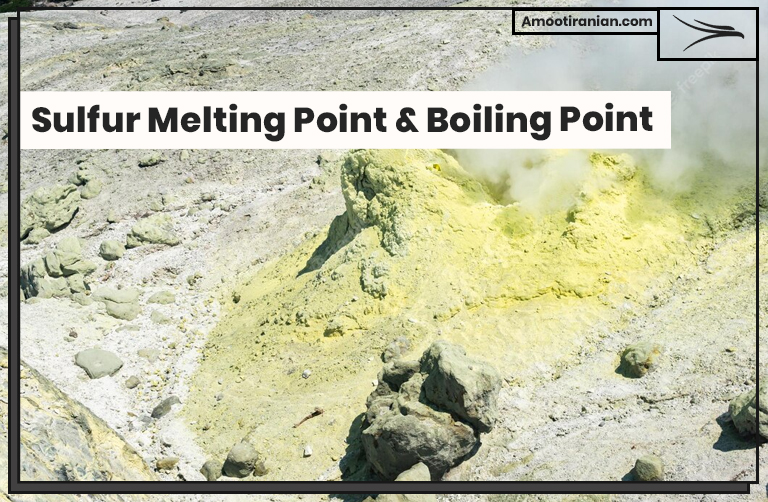.

.
What Is The Melting Point of Sulfur?
Can Sulfur Be Melted? If Yes, At What Temp Is Sulfur Liquid?
Yes, the melting point of sulfur is approximately 115.21 degrees Celsius or 239.38 degrees Fahrenheit.
Melting point is the temperature at which a solid substance changes its state from solid to liquid at a given pressure.
It is the temperature at which the solid and liquid phases of a substance are in equilibrium, meaning that the solid will begin to melt into a liquid and the liquid will begin to solidify into a solid at that temperature.
Melting point is a characteristic property of a substance and can be used to identify it.
How Dangerous Is Molten Sulfur?
Molten sulfur can be dangerous if not handled properly, as it is a hot and corrosive liquid that can cause burns or skin and eye irritation upon contact. The high temperature of molten sulfur also makes it a fire hazard, as it can ignite flammable materials or vapors.
Additionally, sulfur can react with certain materials to form toxic gases, such as hydrogen sulfide, which can be harmful if inhaled.
Therefore, it is important to follow appropriate safety precautions when working with molten sulfur, such as wearing protective clothing, gloves, and goggles, and working in a well-ventilated area.
It is also important to store and handle sulfur and its compounds in a safe manner, following established guidelines and regulations.
How Toxic Is Molten Sulfur?
Molten sulfur itself is not highly toxic, but it can release toxic gases, such as sulfur dioxide and hydrogen sulfide, if it comes into contact with certain materials or is heated to high temperatures.
These gases can be harmful if inhaled in large quantities, causing respiratory irritation, coughing, and difficulty breathing. Prolonged exposure to high concentrations of these gases can lead to more severe health effects, including lung damage and other respiratory problems.
Appropriate protective clothing, gloves, and goggles should be worn when working with molten sulfur to prevent skin and eye irritation. It is also important to follow established guidelines and regulations for the storage, handling, and disposal of sulfur and its compounds to minimize potential risks to health and the environment.
Does Sulfur Melt In Water?
Sulfur is generally not very soluble in water, and it does not melt in water. When sulfur is heated to its melting point, it turns into a liquid state, but it does not dissolve or react with water.
However, if sulfur is finely powdered or divided into small particles, it can react with water to form sulfurous acid and sulfur dioxide gas. This reaction is exothermic and can produce heat, and it can also release toxic sulfur dioxide gas, which can be harmful if inhaled in large quantities.
Therefore, it is important to handle sulfur and its compounds with care and follow appropriate safety precautions.
.
What Is The Boiling Point of Sulfur?
What Temperature Is The Boiling Point Of Sulfur?
The boiling point of sulfur is approximately 444.6 degrees Celsius or 832.28 degrees Fahrenheit.
Boiling point is the temperature at which a liquid substance changes its state from liquid to gas/vapor at a given pressure. It is the temperature at which the vapor pressure of a liquid equals the external pressure exerted on it, causing the liquid to turn into a gas or vapor.
Boiling point is a characteristic property of a substance and can be used to identify it. The boiling point of a substance can be affected by changes in pressure, and the boiling point is typically lower at lower pressures and higher at higher pressures.
Why Sulphur Has High Boiling Point?
Sulfur has a relatively high boiling point compared to other non-metals because of the strength of the covalent bonds between its atoms. Sulfur is a non-metal and exists as S8 molecules, where eight sulfur atoms are covalently bonded to each other through strong covalent bonds.
These covalent bonds are relatively strong because the sulfur atoms share electrons to form a stable octet configuration, which makes it difficult to break the bonds and convert the sulfur from a liquid to a gas.
In addition, the relatively large size of the S8 molecule and the presence of van der Waals forces between the molecules also contribute to the high boiling point of sulfur.
The van der Waals forces between the molecules of sulfur are relatively weak, but they become significant in the solid and liquid phases due to the close packing of the molecules.
As a result, it requires a significant amount of energy to break the intermolecular forces between the sulfur molecules and convert it from a liquid to a gas, which contributes to the high boiling point of sulfur.
